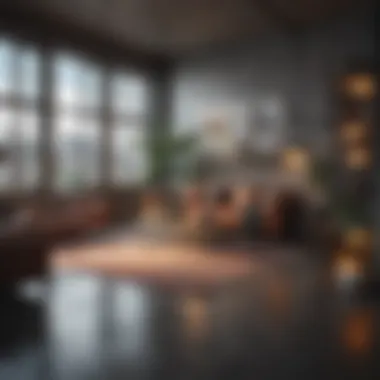Mastering One-Room Living: Design and Functionality


Intro
The growing trend of one-room apartments captivates many, from those seeking a minimalist lifestyle to urban dwellers needing efficient living spaces. This guide provides an in-depth exploration of this unique living arrangement. It revolves around various aspects such as design potential, functionality, and emotional considerations when residing in compact quarters.
One-room apartments challenge the traditional notion of space. They demand innovative thinking and strategic planning. By doing so, they enable individuals to create harmonious environments that reflect personal styles without compromising on comfort.
Key elements such as effective layout optimization, furniture selection, and an understanding of current urban living trends will be discussed throughout the article. Also addressed are budget considerations, emotional aspects of smaller spaces, and the various design inspirations that can shape these apartments into elegant sanctuaries.
This article aims to guide homeowners, design enthusiasts, and travelers. By offering insights, practical advice, and creative solutions, we hope to inspire an appreciation for the art of living in one-room apartments.
Understanding One-Room Apartments
One-room apartments have gained prominence, especially in urban settings. Understanding this housing option is essential for those navigating the real estate landscape, whether they are potential buyers, renters, or design enthusiasts. The appeal lies not only in the compactness but also in the unique lifestyle choices they represent. One-room living can be a deliberate choice, reflecting values such as simplicity, minimalism, and practicality.
These apartments are often characterized by their multifunctional spaces. The layout fosters a sense of intimacy while challenging inhabitants to optimize every square foot. This speaks to the broader trend of urbanization where space is precious, and the demand for housing is soaring.
Definition and Characteristics
A one-room apartment is a self-contained unit that blends living, sleeping, and cooking areas into a single room. These spaces often feature a small kitchen area, a separate bathroom, and little to no distinct separation between the living and sleeping zones. Key characteristics include:
- Efficient Use of Space: The layout must seamlessly integrate all functional areas without sacrificing comfort.
- Compact Design: Often found in metropolitan cities, these units cater to those who seek a simplified lifestyle.
- Versatile Furniture Options: Many one-room apartments utilize furniture that serves multiple purposes, allowing for adaptability in various scenarios.
The Market Landscape
The real estate market for one-room apartments is dynamic, observing shifts based on demographic changes, economic conditions, and evolving lifestyles. Factors impacting this market include:
- Urban Migration: More people are moving to cities, increasing the demand for affordable housing.
- Rising Living Costs: With property prices soaring, one-room apartments present a cost-effective alternative.
- Target Demographics: Young professionals, students, and retirees often find this type of housing appealing due to its accessibility and maintenance ease.
Designing a One-Room Apartment
Designing a one-room apartment involves a unique approach to maximizing functionality while maintaining aesthetic appeal. The importance of this topic is paramount for individuals seeking to create a living space that is both efficient and comfortable. With the rising popularity of compact living, understanding how to design effectively can enhance the quality of life and elevate the overall experience of residing in a small area.
Effective design not only involves selecting the right furniture but also understanding how each component fits into the overall plan.
Maximizing Space Efficiency
Maximizing space efficiency in a one-room apartment is crucial. Every square foot counts, and strategic planning can make a significant difference. Begin by assessing the space and identifying multifunctional areas. Consider utilizing vertical space for storage. It is advisable to install shelving units above eye level, allowing free movement below.
Additionally, open floor plans can provide a more spacious feel. Use zoning techniques, such as area rugs or furniture placement, to define different sections within the room without constructing solid walls. This flexibility can enhance usability.
Key strategies for maximizing space include:
- Choosing furniture that can serve multiple purposes, such as a sofa bed or an ottoman with storage.
- Keeping clutter to a minimum to ensure the space feels open and inviting.
- Using mirrors to create the illusion of depth and make the space feel larger.
Utilizing these tactics contributes to an efficient and comfortable living environment.
Color Schemes and Light Management
Color schemes have a profound impact on the perception of space. In small apartments, lighter colors are generally more effective as they reflect light and create an airy feel. Soft whites, light grays, or pastel shades can open up the room, making it appear more expansive.
Moreover, light management plays a vital role in the ambiance. Natural light should be maximized. Avoid heavy drapes that block sunlight; instead, opt for sheer curtains or blinds that let light filter through. Positioning mirrors opposite windows can help to bounce light around the room, enhancing brightness.
Selecting a cohesive color palette that flows smoothly from one area to another can aid in creating a harmonious environment. Incorporating accent colors through decor items can add personality and depth without overwhelming the senses.
Furniture Selection and Arrangement
Furniture selection is a critical aspect of designing a one-room apartment. The right furniture can elevate the space. Prioritize scale when choosing items. Large sofas or bulky tables can overcrowd a small apartment. Instead, consider streamlined options that maintain comfort while being lighter visually.


Arrangement of furniture should encourage ease of movement. Avoid blocking pathways to create a logical flow throughout the space. Position larger pieces, such as beds or sofas, against walls to free up the center of the room.
It is recommended to invest in quality pieces that offer durability and style. This ensures that the design remains effective over time, even as personal tastes evolve.
"Thoughtful design can transform a one-room apartment into a sanctuary of comfort and style."
In summary, designing a one-room apartment requires a balance of creativity and practicality. Maximizing space efficiency, managing colors and lighting, and carefully selecting and arranging furniture contribute to a harmonious living environment. Being mindful of these aspects enables individuals to enhance both functional and emotional experiences in their living space.
Functional Aspects of One-Room Living
One-room living is a distinctive choice, emphasizing innovative use of space. Its functional aspects hold significant importance in this context. Every square foot must serve a purpose. This practicality is not just about minimizing clutter; it’s about enhancing everyday life. By focusing on the functional elements of one-room apartments, residents can achieve a balance between comfort and efficiency.
Dual-Purpose Furniture
One of the cornerstones of effective space management in a one-room apartment is dual-purpose furniture. By choosing items that serve multiple functions, one can significantly reduce the need for excess furnishings. For instance, a sofa bed provides seating during the day and converts into a bed at night. This versatility is particularly beneficial in small living spaces.
Another great example includes coffee tables with hidden storage. Such tables allow residents to store essentials like books or blankets without sacrificing style. When selecting dual-purpose furniture, consider the following:
- Functionality: Ensure that the item effectively serves its dual purpose.
- Size: Choose items that fit well into the available space without overwhelming it.
- Aesthetic: Balance practicality with design.
Dual-purpose furniture not only economizes space but also adds a layer of creativity to interior design. The right pieces can influence the overall ambiance, making the space feel larger and more refined.
Storage Solutions
In one-room living, effective storage solutions are crucial. They enable residents to maintain order, which positively impacts mental well-being. Clutter can lead to stress and decrease overall enjoyment of the living environment. Therefore, smart storage choices are essential.
Consider vertical storage options like shelving units that reach towards the ceiling. This takes advantage of often under-used space and provides ample room for decorative items or necessary belongings. Additionally, using multi-function furniture with built-in storage can be beneficial. For example, ottomans that open up for storage can serve as both seating and a place to store items.
Other strategies for maintaining order include:
- Under-bed storage: Utilize compartments or boxes for off-season clothing.
- Hooks and wall-mounted racks: Keep items like keys and bags organized and accessible.
- Baskets and bins: These add a decorative element while providing functional storage.
Overall, a thoughtful approach to storage enhances the living experience in one-room apartments. With these strategies in place, it is possible to create a functional living space that supports both daily activities and personal style.
"In smaller living spaces, every design choice influences overall well-being. Storage solutions play a vital role in creating a serene environment."
Urban Living Trends
Understanding the dynamics of urban living trends is vital for anyone considering or already embracing one-room apartments. These compact spaces, once relegated to the fringes of residential options, are now becoming a mainstream choice for many in bustling metropolises. This shift is not just due to space limitations but reflects a broader transformation in lifestyle priorities, values, and housing demands.
Urbanization continues to surge, with more people moving to cities for job opportunities and lifestyle options. Consequently, the demand for efficient and affordable living arrangements has intensified. One-room apartments, often smaller but more strategically designed, present an attractive solution. They cater to young professionals, students, and even retirees seeking lower living expenses without sacrificing quality of life. In this context, the importance of recognizing the trends surrounding one-room living becomes clear.
The Rise of Tiny Living
Tiny living has found its place in the hearts of many urban dwellers. With rising real estate prices and the desire for minimalism, tiny homes or one-room apartments are appealing options. This movement emphasizes simplicity, sustainability, and efficiency, promoting a lifestyle that embraces fewer possessions and high-quality experiences.
Some factors contributing to the rise of tiny living include:
- Affordability: Smaller living spaces generally come with lower rent or mortgage costs, allowing individuals to allocate funds elsewhere, such as travel or savings.
- Sustainability: Eco-conscious living encourages individuals to downsize and reduce their environmental footprint, leading to a greener approach to urban dwelling.
- Flexibility: One-room apartments offer residents the freedom to alter their space as needed, whether they are working from home or entertaining guests.
Sustainability Considerations
Sustainability plays a crucial role in the future of one-room apartments within urban environments. As awareness of climate change and environmental degradation grows, more individuals are making choices that reflect their values. One-room living aligns well with this mindset, providing opportunities for sustainable living.
Key considerations include:
- Energy Efficiency: Smaller spaces require less energy for heating and cooling, contributing to reduced utility bills and lower carbon emissions.
- Material Choices: Many modern one-room apartments incorporate sustainable materials in their construction and design. This includes repurposed wood, recycled metals, and low-VOC paints, enhancing indoor air quality and minimizing harm to the environment.
- Community Initiatives: Urban developments increasingly focus on incorporating green spaces and communal areas, promoting a sense of community while benefiting local ecosystems.


"Tiny living is not just a trend; it’s a movement towards sustainable urbanization that fosters a simpler, more conscious lifestyle."
The overlapping trends of urban living, tiny houses, and sustainability highlight the shift towards a more thoughtful approach to modern life. As one-room apartments continue to gain prominence, the focus on creating efficient, stylish, and eco-friendly spaces will likely remain a core aspect of urban living.
Personalization in Small Spaces
Personalizing a one-room apartment elevates the living experience from mere functionality to a holistic expression of self. These small spaces, unlike larger homes, present unique challenges. Yet, embracing personalization transforms them into genuine reflections of individuality. By infusing personal style into a compact area, residents can create environments that feel both intimate and inviting.
Focusing on the small footprint of these apartments can enhance the overall aesthetic without sacrificing usability. Personalized elements not only cultivate a sense of belonging but also aid in creating an emotional connection to the space.
Incorporating Personal Style
When considering how to incorporate personal style into a one-room apartment, think about favorite colors, themes, or even cherished memories. This all can infuse energy into the living space. Here are some strategies to consider:
- Choose a Color Palette: Selecting a cohesive color scheme can tie different elements together, making the space feel harmonized.
- Select Meaningful Furniture: A piece of furniture that tells a story can serve as a conversation starter and add character.
- Layer Textiles: Utilize pillows, throws, and rugs that bring in textures; this can make a space feel cozy and inviting.
Designers often suggest that style should be functional as well. This means opting for furniture that suits personal taste while also serving a purpose. The result is a character-rich environment that does not compromise comfort or utility.
Artwork and Decor Choices
Art and decor play a pivotal role in one-room apartments. They can dramatically alter how the space feels. Unique artwork can serve as focal points, making rooms appear larger or infinitely more engaging. Here are some considerations:
- Display Personal Artwork: Hang pieces that evoke memories or experiences, allowing the walls to reflect personal journeys.
- Use Mirrors: Mirrors can enhance the perception of space and light, serving dual functions as decor and spatial illusion.
- Incorporate Plants: Adding greenery not only purifies the air but also contributes life to a room, reinforcing a sense of calm and connection to nature.
"Art is not what you see, but what you make others see."
- Edgar Degas
Ultimately, careful curation of art and decor allows for functional enhancements while still infusing the space with personal elements. The key is to maintain a balance between aesthetic appeal and practical living, ensuring that personalization does not detract from the space's purpose.
Budgetary Considerations
Understanding the financial implications of living in a one-room apartment is crucial. These considerations not only influence one's capability to afford such a space but also impact the overall living experience. By evaluating various budgetary factors, potential residents can make informed decisions about their future homes. One-room apartments can offer a more affordable alternative to larger spaces, but it is essential to dig deeper into costs and benefits.
Rental prices for one-room apartments typically vary by location and amenities offered. Major cities often see higher prices, which may be influenced by demand and neighborhood attractiveness. Therefore, one should look at costs beyond rent. Utilities, maintenance fees, and property taxes should also be accounted for when creating a budget.
Moreover, budgetary considerations play a significant role in determining the type of furnishings and décor one can afford. Making smart spending choices can maximize comfort and utility without breaking the bank.
Cost-Effective Design Strategies
Implementing cost-effective design strategies can significantly enhance the overall appeal of a one-room apartment while respecting a budget. Here are some effective approaches:
- Buy Second-Hand Furniture: Thrift stores or online platforms often house unique furniture pieces at lower prices. This not only saves money but also adds character to the space.
- Multi-Function Furniture: Investing in furniture that serves multiple purposes can be a game changer. For instance, a sofa bed or a coffee table that transforms into a desk can help save space and minimize unnecessary costs.
- DIY Projects: Engaging in do-it-yourself projects can be both rewarding and cost-saving. Simple decorations like wall art or shelves can be made at home, bringing in a personal touch while saving money.
Underpinning these strategies with careful planning and creativity can yield a vibrant and functional living space without overspending.
Long-Term Value of One-Room Apartments
Evaluating the long-term value of one-room apartments reveals several prospects that make them attractive investments. Not only can these apartments serve as a starter home, but they can also provide excellent potential returns down the line.
Firstly, the maintenance costs associated with smaller living spaces tend to be lower. Because they require less upkeep, residents enjoy reduced expenses over time, resulting in more financial freedom.
Secondly, as urban areas expand, one-room apartment demand is expected to rise. This growing interest can lead to increased property values, making them a wise investment choice.
Additionally, one-room apartments often cater to diverse demographics, from students to young professionals, thus ensuring consistent rental income for investors.
Emotional Aspects of One-Room Living


Understanding Emotional Aspects of One-Room Living is vital, especially for those considering this type of accommodation. Living in a small space can impact mental health and overall quality of life. It is essential to explore the psychological effects and the benefits of community and personal space in this unique living arrangement.
Mental Well-Being in Smaller Spaces
Living in a compact environment can foster both positive and negative emotional outcomes. For many, the challenge lies in the limited square footage, which can sometimes lead to feelings of confinement or overstimulation. However, with careful planning, one can experience a sense of calm and organization.
Research suggests that organized and well-designed small spaces can significantly enhance mental well-being. Here are some strategies to create a positive atmosphere:
- Declutter Regularly: Keeping space organized reduces anxiety and enhances focus.
- Incorporate Natural Light: Light enhances mood. Ensure windows are unobstructed.
- Choose Calming Colors: Soft hues create a serene environment and comfort.
A well-arranged one-room apartment can transform into a personal sanctuary, isolating one from the chaos of the outside world. Many residents report that smaller living encourages a minimalist mindset, leading to life choices that prioritize mental clarity.
The Community Aspect
Another important emotional aspect of one-room living is its potential for fostering community. Smaller complexes often develop a neighborly atmosphere. Social connections thrive in these environments because residents frequently interact in shared spaces. This interaction can lead to meaningful friendships and support networks.
Consider these community advantages:
- Shared Experiences: Regular gatherings or activities help build rapport.
- Emotional Support: Neighbors become a source of assistance or companionship.
- Safety in Numbers: Familiar faces promote a feeling of safety.
"Communities in one-room settings often become families in their own right, providing both social interaction and support, which is vital for emotional well-being."
Future of One-Room Apartments
The future of one-room apartments demonstrates a shift in living patterns, particularly in urban areas. These small units have gained popularity due to their affordability, efficient design, and adaptability to the increasing demand for housing. In this section, we will examine two crucial aspects: Evolving Design Trends and Potential in Urban Development. Understanding these elements is vital as they shape how one-room apartments will accommodate their residents in the coming years.
Evolving Design Trends
As cities expand and the population increases, design trends adapt to meet the need for compact living spaces. One prominent trend is the integration of smart technology. Home automation systems enhance comfort and efficiency. From smart lighting to temperature control, these systems elevate the functionality of small spaces.
Moreover, modular furniture continues to gain traction. These versatile pieces can transform a living area into a workspace or sleeping quarter within minutes. Furniture brands, such as IKEA and West Elm, are focusing on designs that stack, fold, or offer dual functions. This flexibility supports the minimalist lifestyle that is often sought after in one-room living.
Another consideration is biophilic design. This approach incorporates natural elements into modern living spaces, advocating for plants and natural light to boost well-being. For residents of one-room apartments, these features can create a connection to the outdoors, making the space feel larger and more inviting.
Potential in Urban Development
Urban developers are increasingly seeing the potential in one-room apartments as viable solutions to housing crises. These units can address affordability issues while ensuring efficient land use. Cities like Tokyo and New York illustrate models where high-density living surrounds essential amenities, reducing the need for extensive travel.
Furthermore, policies promoting sustainable urban growth often favor smaller living spaces. By investing in one-room apartments, cities can decrease their environmental footprint. Compact living encourages public transport usage and reduces reliance on cars, contributing positively to urban ecology.
"The compact living trend marks a significant change in urban housing solutions. It reflects a desire for sustainability, efficiency, and community engagement."
The future holds promise for one-room apartments as they respond to societal shifts and urban needs. The strengths of such housing options lie in their adaptability and design potential, shaping tomorrow's living experiences.
Culmination
Understanding the dynamics of one-room apartments is crucial for several reasons. As urban environments continue to evolve, the appeal of compact living spaces increases, making it essential for individuals and families to adapt. This article highlights not only the functional aspects of one-room apartments but also their design potential and the emotional benefits they offer.
A key element is space optimization. One-room apartments challenge the notion of traditional living spaces, requiring innovative design and furnishing solutions that promote efficiency. By embracing compact living, residents can create a more organized and devoid of clutter lifestyle. This awareness encourages a simpler approach to material possessions, fostering mindfulness in daily living.
From a financial perspective, one-room apartments often come with reduced costs, lower utility bills, and decreased maintenance responsibilities. This affordability aligns well with the growing trend of sustainability. Living in smaller spaces can significantly reduce one's environmental footprint, promoting resource conservation and responsible consumption.
Embracing Compact Living
Embracing compact living is not merely about residing in a small space; it represents a lifestyle choice grounded in practicality and intentionality. In one-room apartments, every square foot counts, requiring residents to maximize their environment effectively.
Incorporating multi-functional furnishings is a critical strategy in achieving this goal. For instance, a sofa bed or an extendable dining table allows residents to adapt their spaces according to immediate needs. This adaptability fosters a sense of ownership and creativity in design, allowing individuals to personalize their homes.
Moreover, the emotional aspects of living in a one-room apartment can be profound. The intimacy provided by a smaller living space can enhance relationships and foster a close-knit atmosphere, especially in urban settings where community engagement plays a vital role. As people navigate life in compact quarters, they often prioritize social connections, enhancing their overall well-being.
As we look toward the future, one-room apartments will continue to hold significance in urban development. Their integration into modern city planning showcases a response to increased population density and housing demands. Recognizing this trend can prepare us for the realities of urban living.
Ultimately, embracing compact living encourages not just a change in physical surroundings, but also a shift in mindset. By learning to appreciate less space while maximizing its potential, individuals can lead fulfilling lives in thoughtfully designed environments.



